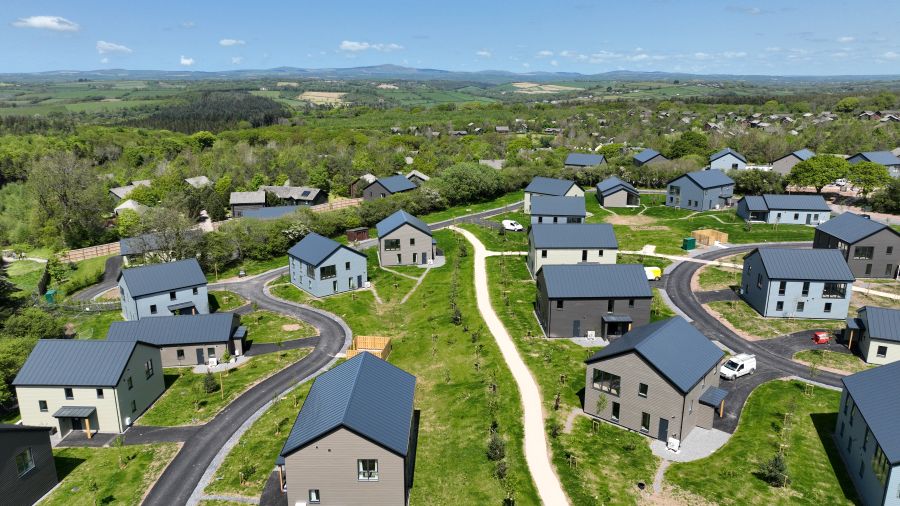Housing Specification talked to Lorraine Scott, Business Development Manager of Sto, who takes a look at how the industry is reacting to government initiative.
It is no secret that if the UK is going to meet its carbon reduction obligations then the way we design and occupy buildings is going to have to change. Building Regulations have brought about significant changes in the performance of new housing, but 80% of the houses that will be standing in 2050 are already built. 25% of these date from before 1919. The challenge is to bring these aging structures up to modern levels of energy efficiency.
This year sees the introduction of the Government’s two key policies to drive improvement in existing buildings: Green Deal and the Energy Company Obligation (ECO). Green Deal places the onus on the houseowner to apply for funding and, in our view, is likely to take time to build momentum. ECO, on the other hand, requires the energy companies to distribute specified funds for improvement works on homes within prescribed timescales and is therefore likely to lead to active projects sooner.
ECO is also specifically geared to consider improvements that are too costly to fit within the financial constraints (the “golden rule”) of Green Deal and yet are considered worthwhile in terms of their carbon saving potential. The particular areas targeted under ECO are solid wall insulation and hard to treat cavities.
In designing this scheme the government has taken into account the potential for energy efficiency improvements within the current housing stock. In its Impact Assessment Report of 2012, the Department for Energy and Climate Change (DECC) suggested that, of potential energy savings within the domestic housing sector, just 15% could be supplied with loft insulation or easy to treat cavity wall insulation. The remaining potential is split between solid wall insulation (67%) and hard to treat cavity wall insulation (18%).
Or, to look at it another way, there are around 7 million homes in the UK with the potential to fit solid wall insulation. DECC estimates that, with ECO funding in place, there will be around 100,000 projects involving solid wall insulation per year by 2015.
The Impact Assessment document considers the options for achieving this type of insulation. Essentially there is a choice between fitting insulation on the interior or exterior of the wall and the cost implications of both methods are considered.
At first sight internal insulation looks less costly as there are fewer technical challenges involved. However, once consequential costs (such as the entire redecoration of the interior, including skirting boards and decorative ceiling plaster, moving of radiators and electrical sockets etc) are taken into account, the figures look less appealing. For landlords, the disruption and cost of decanting tenants from their homes during the works may rule this option out completely.
This leaves external wall insulation (EWI) as the best solution. An EWI System is comprised of a number of constituent parts. Firstly the insulation (either EPS or mineral fibre) is fixed to the exterior using either adhesive or mechanical fixings. This is then coated with a reinforcing render which is itself strengthened with an embedded reinforcing mesh. Finally the system is finished with either a coloured render topcoat or a dash or brick slip depending on the aesthetic required. The system can be applied to any substrate material and options exist for either mechanical or adhesive fixings. The degree of insulation can be dictated by varying the thickness of the insulating layer – most retrofit projects look to achieve a U-value of 0.3 W/m2K.
Applying External Wall Insulation will change the appearance of the property: the depth of the insulation will increase the window reveals and alterations may be required to the roofline and to doors and other detailing to accommodate this. Brick slips, colour matched to the local brick style will ameliorate the change while coloured render can be used to enhance the façade appearance. However, recognising that planning issues could be a barrier to the adoption of EWI, the Department for Communities and Local Government issued guidance in January 2013 suggesting that External Wall Insulation will now be regarded as an “improvement” and therefore should not be subject to planning constraints.
All these considerations make it very clear that there is potentially a huge market for external wall insulation and there is no shortage of suppliers eager to provide solutions. The challenge will be to find companies with the technical and practical expertise to ensure the installation will perform as anticipated in the longer term.
Sto has been manufacturing rendered external wall insulation for decades and is the European market leader. It has built its reputation on product excellence and the level of technical support provided to specifiers and applicators. However, with cost effectiveness a key consideration for domestic properties, Sto has reconsidered its product offer and used Ecobuild 2013 to launch its Stomix brand: a new range of External Wall Insulation Systems specifically designed for the ECO funded housing refurbishment sector.
Capitalising on its experience and technical understanding, Sto can confidently support this new range, while meeting the requirements for cost effective solutions. Just as significantly, Sto is also investing in a new training academy to support applicators and specifiers looking to understand the implications of retrofitting insulation to solid wall properties.
With the ECO scheme set to inject some much-needed funding into the refurbishment market we anticipate a number of manufacturers will introduce EWI systems: the test will be how many of those organisations have the expertise and technical back-up to support a rapidly growing market.




















